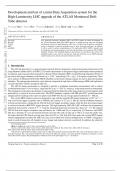Examen
Development and test of a mini-Data Acquisition system for the High-Luminosity LHC upgrade of the ATLAS Monitored Drift Tube detector
- Grado
- Institución
1. Introduction The ATLAS detector [1] is a general-purpose particle detector designed to study proton-proton interactions at the Large Hadron Collider (LHC) at CERN [2]. Its muon spectrometer is designed to trigger and identify muons produced in collisions and to measure their momenta [3]. Resi...
[Mostrar más]



